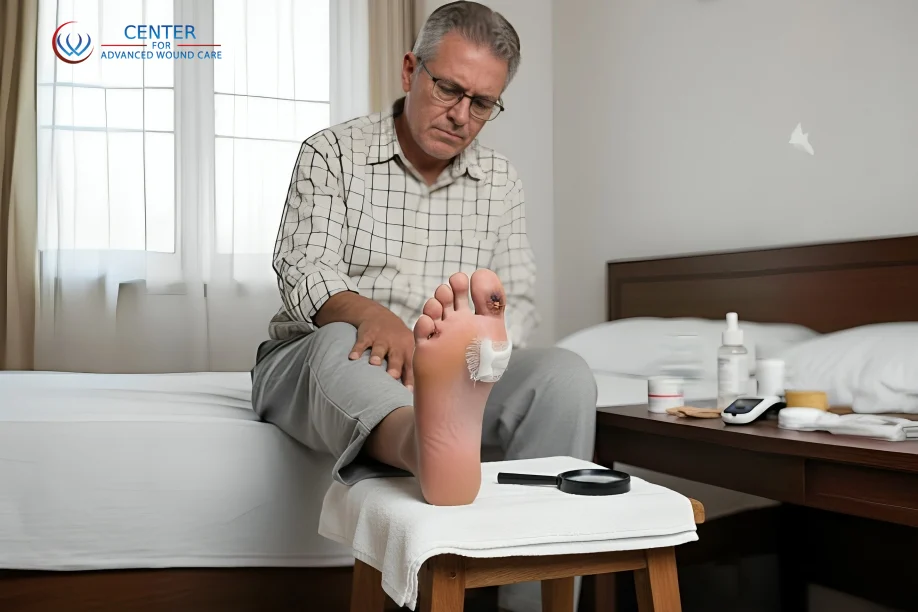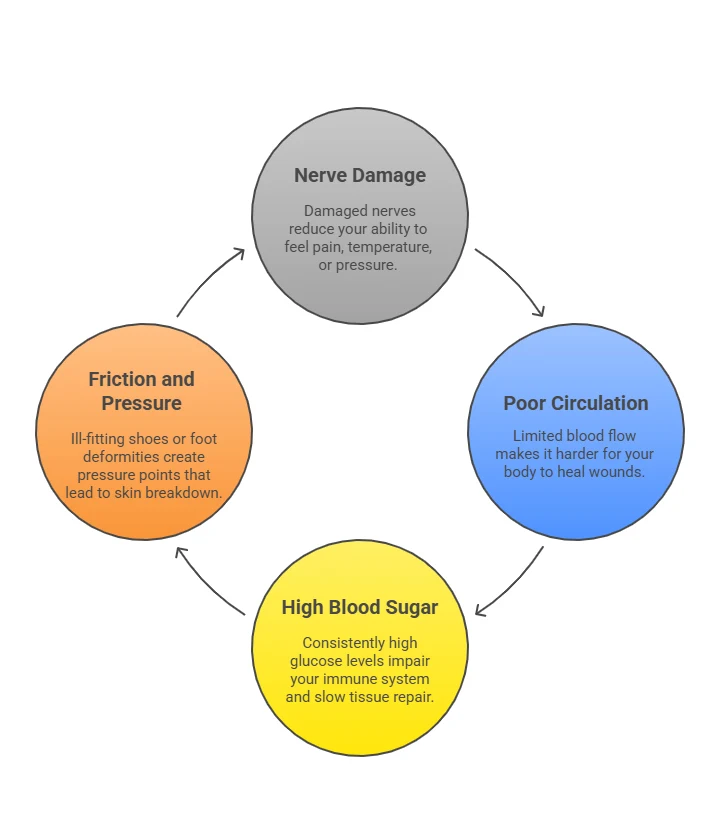
What are the early signs of a diabetic foot ulcer?
What are the early signs of a diabetic foot ulcer?
Table of Contents
ToggleQuick Summary: Early Signs of a Diabetic Foot Ulcer
- Redness and Swelling Signal Early Inflammation – Red or swollen skin, especially on the toes or soles, is often the first visible warning of an ulcer forming.
- Warmth or Fluid Drainage Suggests Infection – Warmth, damp socks, or visible drainage indicate tissue irritation or early infection beneath the skin.
- Calluses or Corns May Hide Developing Ulcers – Thickened skin in high-pressure spots can mask an underlying sore or wound.
- Pain, Tingling, or Numbness Reflects Nerve Damage – Nerve issues from diabetes reduce sensation, allowing wounds to progress unnoticed.
- Slow-Healing Sores Need Prompt Medical Care – Any blister or open spot that won’t heal within a week can evolve into a diabetic foot ulcer and should be evaluated immediately.
If you’re living with diabetes, paying close attention to your feet can make a huge difference in protecting your health. One of the most common and serious complications of diabetes is the diabetic foot ulcer. These ulcers often begin as small, painless wounds but can progress rapidly if left untreated.
Early signs of a diabetic foot ulcer may include redness, swelling, warmth, or the appearance of a small sore, blister, or wound that doesn’t heal. You might also notice a foul odor or fluid drainage from the affected area, and calluses or corns may start forming in spots that experience pressure. Recognizing these subtle changes early can prevent infection and long-term damage. In this blog, we’ll discuss the early signs of a diabetic foot ulcer, what causes them, and what a diabetic foot ulcer looks like.

What are Diabetic Foot Ulcers
A diabetic foot ulcer is an open sore or wound that usually appears on the bottom of the foot. People with diabetes are at higher risk because long-term high blood sugar can damage nerves and blood vessels, leading to reduced sensation and slower healing.
When you can’t feel pain, even a tiny cut or blister might go unnoticed. Over time, it can deepen, become infected, and in severe cases, lead to tissue damage or amputation. That’s why recognizing the earliest signs of a diabetic foot ulcer is critical.
What Causes Diabetic Foot Ulcers?
Understanding what causes diabetic foot ulcers helps explain why they can appear suddenly. Common causes include:

Now that you know why ulcers form, let’s look at how to identify them early.
The Early Signs of a Diabetic Foot Ulcer
Detecting a diabetic foot ulcer in its early stage gives you the best chance for fast healing and fewer complications. Here are the key early warning signs to look for, and what each one could mean.
1. Redness or Skin Discoloration
The first noticeable change is often redness or dark patches of skin, especially around the toes, heel, or sole. The area might look slightly inflamed or irritated. Because people with diabetes may not feel pain, this redness can easily be overlooked.
If you notice that the skin color changes persist for several days or appear in high-pressure areas, it could be the beginning of an ulcer forming under the skin.
2. Warmth and Swelling
If your foot feels warm to the touch or appears swollen compared to the other foot, it’s a sign that your body is reacting to injury or infection.
Swelling occurs as fluid builds up around irritated or damaged tissue, and warmth can indicate early inflammation. This is one of the most common early diabetic foot infection symptoms and should be checked immediately.
3. Calluses or Hardened Skin
A callus is a thickened patch of skin that forms from pressure or friction. While calluses might seem harmless, they can actually hide developing ulcers underneath.
When the skin thickens too much, it can crack, creating small openings where bacteria enter. If you see yellow or gray calluses on your feet, especially if they’re painful or have a dark spot in the middle, it’s time for a foot exam.
4. Fluid Drainage or Wet Spots on Socks
One of the earliest physical signs that an ulcer is forming is fluid drainage. You might notice clear or slightly yellowish stains on your socks or inside your shoes.
This drainage happens when the skin breaks and fluid from the wound seeps out. Even if the sore isn’t visible yet, any persistent moisture or staining should raise concern; it’s a red flag for early ulceration.
5. Foul Odor
A bad smell coming from your foot can indicate an underlying infection. This usually occurs when bacteria begin multiplying in an open wound. Even if you don’t see a visible sore, an unpleasant odor, especially when combined with drainage or swelling, is a sign to seek professional care right away.
6. Pain, Tingling, or Numbness
Nerve damage caused by diabetes can lead to pain, burning, tingling, or complete numbness in your feet. Ironically, losing sensation is what makes ulcers so dangerous; if you can’t feel pain, you might not realize a wound is developing.
If your feet feel “different” in any way, too hot, too cold, numb, or painful, it’s worth having them checked by a wound care specialist.
7. Small Open Sore That Doesn’t Heal
Perhaps the most obvious early sign of a diabetic foot ulcer is a small open sore that refuses to heal. This might look like a blister, scratch, or shallow wound that stays red and moist.
If the sore lingers for more than a week or starts draining, it’s important to get it evaluated by a professional. Untreated ulcers can deepen and expose the tissue or bone beneath.
8. Black or Dark Tissue Spots
When blood flow is severely restricted, parts of the tissue may begin to die, leading to black or dark patches called eschar. Even a small dark spot surrounded by redness is a serious warning sign of reduced circulation and possible infection.
At this stage, professional wound care is essential to prevent further damage and encourage healing.
What Does a Diabetic Foot Ulcer Look Like?
A diabetic foot ulcer often starts as a red or shallow open wound with surrounding inflammation. In early stages, the edges might appear raised or callused, and you may see clear fluid or a yellowish layer of dead skin. As it worsens, the ulcer can become deeper, produce drainage, or develop a dark center.
If you notice anything resembling this description, don’t wait for it to improve on its own. Prompt evaluation and treatment are key to recovery. Our expert team at The Center for Advanced Wound Care specializes in advanced wound management and can help you heal safely and effectively.
Conclusion
Recognizing the early signs of a diabetic foot ulcer, such as redness, swelling, calluses, fluid drainage, or small unhealed wounds, can prevent serious complications and speed up recovery. With diabetes, every minor change in your feet deserves attention.
If you suspect you’re developing an ulcer or are noticing any unusual symptoms, don’t wait. Reach out to our wound care specialists for personalized treatment and guidance. Contact us today to schedule an appointment and take the first step toward healthier, pain-free feet.
Frequently Asked Questions:
1. What are the earliest signs of a diabetic foot ulcer?
The earliest signs include redness, swelling, warmth, and a small sore or blister that doesn’t heal. You might also notice drainage, a foul odor, or thickened skin in pressure areas.
2. How can I tell if a sore is turning into a diabetic ulcer?
If a sore becomes warm, swollen, drains fluid, or doesn’t heal within 7–10 days, it may be turning into a diabetic ulcer. Any change in color, size, or smell is a red flag.
3. Where do diabetic foot ulcers usually form?
Most ulcers develop on the bottom of the foot, especially under the big toe, heel, or ball of the foot, where friction and pressure are highest.
4. Do diabetic foot ulcers hurt?
Not always. Many people with diabetes experience neuropathy (nerve damage), which reduces pain sensation, so ulcers can form and worsen without noticeable discomfort.
5. What causes diabetic foot ulcers to develop?
They’re mainly caused by poor circulation, high blood sugar, and nerve damage. Ill-fitting shoes or unnoticed injuries can also lead to ulcer formation.
6. How does a diabetic foot ulcer look in the beginning?
Early ulcers may appear as red or shallow open wounds surrounded by inflamed skin. Over time, they can develop drainage, thick edges, or dark tissue.
7. Can diabetic foot ulcers heal on their own?
No. These wounds typically require professional medical care to prevent infection and promote proper healing. Ignoring them can lead to serious complications.
8. What should I do if I notice early signs of a diabetic foot ulcer?
Clean the area gently, avoid pressure on the foot, and contact a healthcare provider as soon as possible. Early treatment helps prevent deep tissue damage or infection.
9. Are diabetic foot ulcers preventable?
Yes. Daily foot checks, wearing proper footwear, managing blood sugar, and keeping feet clean and dry can significantly lower your risk.
10. When should I see a doctor for a diabetic foot problem?
If you notice redness, swelling, drainage, or a sore that doesn’t heal within a week, seek medical attention immediately to prevent complications.


